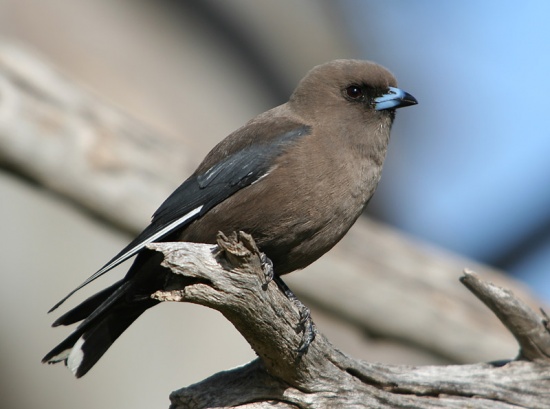(References updated) |
(Add photo) |
||
| Line 27: | Line 27: | ||
==Behaviour== | ==Behaviour== | ||
Often seen perched. Forages singly, in pairs or small groups. Often in mixed-species flocks. | Often seen perched. Forages singly, in pairs or small groups. Often in mixed-species flocks. | ||
| + | [[Image:1152 Woodswallow, Dusky 15d.jpg|thumb|450px|right|Photo by {{user|peterday|peterday}}<br>Alligator Gorge, South Australia [[Australia]], October 2017]] | ||
====Diet==== | ====Diet==== | ||
Feeds mostly on insects taken on the wing, takes also nectar. | Feeds mostly on insects taken on the wing, takes also nectar. | ||
Revision as of 10:59, 26 November 2017
- Artamus cyanopterus
Identification
- Deep brown-grey
- Dark blue grey wings with white edges
- White patch on outer wing
- Black tail has broad white tip
- Silver-white underwings
- Blue bill with black tip
- Dark brown iris
Sexes similar
Juvenile
- Grey brown with buff and cream streaks and mottling
Similar species
Little Woodswallow is smaller and has no white line on wing.
Distribution
Found in south, southeast and east Australia, including Tasmania.
Locally common in its range.
Taxonomy
There are 2 subspecies:
- A. c. cyanopterus in east and southeast Australia, Tasmania, Kangaroo Island and islands in Bass Strait
- A. c. perthi from southwest Australia east to Eyre Peninsula
These two subspecies are only weakly differentiated and integrade in south Australia.
Habitat
Woodland, open forests and agricultural area.
Behaviour
Often seen perched. Forages singly, in pairs or small groups. Often in mixed-species flocks.
Diet
Feeds mostly on insects taken on the wing, takes also nectar.
Breeding
Breeding season from August to February. Usually a solitary nester, sometimes co-operative with helpers. The bowl shaped nest is built by both sexes from twigs, grass and roots, and is lined with fine grass. Lays 2 - 3 eggs. Both sexes incubate the eggs and care for the young.
Southern populations migrate north in austral winter, eg leaving Tasmania in April and returning in October.
References
- Clements, JF. 2011. The Clements Checklist of Birds of the World. 6th ed., with updates to August 2011. Ithaca: Cornell Univ. Press. ISBN 978-0801445019. Spreadsheet available at http://www.birds.cornell.edu/clementschecklist/downloadable-clements-checklist
- Del Hoyo, J, A Elliott, and D Christie, eds. 2009. Handbook of the Birds of the World. Volume 14: Bush-shrikes to Old World Sparrows. Barcelona: Lynx Edicions. ISBN 978-8496553507
Recommended Citation
- BirdForum Opus contributors. (2025) Dusky Woodswallow. In: BirdForum, the forum for wild birds and birding. Retrieved 15 January 2025 from https://www.birdforum.net/opus/Dusky_Woodswallow






